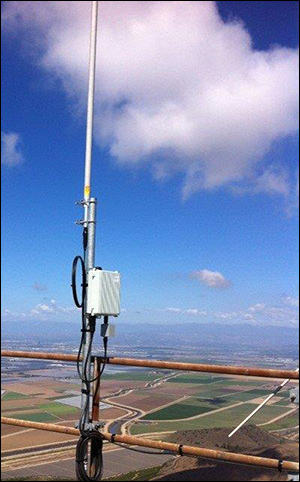Senet, a New Hampshire company that is deploying a public low-power wide-area network (LPWAN) for Internet of Things applications, reports that it has achieved coverage in 110 U.S. cities and plans to double that number during the next year. The network supports the LoRa Alliance‘s communication standard, developed by IBM and chipmaker Semtech.
“Our strategy is to be the leading provider of public, multi-tenant LPWAN in North America, using the LoRa standard to deliver on that,” says Will Yapp, Senet’s VP of business development and marketing. “Our business model is that of a subscription, not dissimilar from the cellular [communications] model, billed per month, per device, based on data usage.”
Senet has deployed gateways across New England and some parts of the Midwest, as well as in or near several major cities in California. Thus far, many of the company’s customers are using the network for agricultural applications, in which sensors that track such variables as soil moisture or pH levels transmit their data to Senet gateways, or for collecting data transmitted by sensors at remote oil and gas extraction sites. That’s part of the reason that Senet’s network, despite covering 100 U.S. cities (a city being defined as having more than 50,000 residents), reaches only 8 to 9 percent of the United States’ population. Yapp says Senet is now focused on expanding the network to the 10 largest U.S. cities as it begins to serve smart-city applications, in which Senet gateways will collect data from utility meters or building management, or from transportation-related systems.
Senet grew out of, and still owns, EnerTrac, a company founded in 2009 as a service to help fuel-service businesses to remotely monitor the level of propane or oil inside tanks at its customers’ sites. Aside from EnerTrac, which has deployed sensors in 50,000 fuel tanks throughout the United States, Senet is unable to name any of its other customers, Yapp says.
The company recently began partnering with other gateway manufacturers—namely, MultiTech and Kerlink—to deploy what it calls microcell gateways. To date, more than 50 microcells complement Senet’s main (macrocell) public IoT network, which comprises 130 gateways deployed on towers around the United States. Unlike the tower-mounted receivers, the microcell gateways can be deployed quickly and cheaply, and are used to support such specific applications as monitoring soil moisture levels or smart city applications.
A macrocell gateway provides communication coverage within a radius of 15 to 50 miles, depending on topography, which can interfere with a line of sight between a sensor and the tower where the gateway is mounted. Each macrocell gateway can handle transmissions from tens of thousands of LoRa radios embedded in the sensors. The microcells are generally installed on buildings, in urban areas, or on water tanks or other fixed objects within rural areas. A microcell provides coverage within a radius of 1 to 5 miles, and can handle the transmissions of thousands of LoRa radios. Both macrocell and microcell gateways can use either a cellular link or an Ethernet backhaul to send the sensor data to cloud-based servers.
As it is already doing for its microcells, Senet plans to begin sourcing its macrocell gateways from third parties. This strategy, Yapp notes, will enable Senet to lower its operational costs—a savings that will ultimately be passed on to end users.
Last week, Senet announced a partnership with Objenious, a subsidiary of French telecommunications firm Bouygues Telecom, to enable IoT solution providers to use LoRa-based sensors in both North America and France, leveraging their respective networks. Objenious reports that it will provide LoRa coverage across France by the end of the year.
Software provider Actility and chip-maker Semtech are two other companies that are working together to build out LoRa-based LPWAN infrastructure in the United States, Europe and elsewhere, and that seek to make LoRa a go-to standard for IoT applications in which small packets of data are sent over long distances. The LoRa Alliance works to bring stakeholders together and advance the technology.
But French company Sigfox, which recently announced plans to work with Atari to integrate its radios into upcoming consumer products, has been busy building out a competing network using its own proprietary LPWAN standard. In the United States, Sigfox has established networks of gateways in California’s Bay Area (San Francisco and Silicon Valley) and Los Angeles, as well as in Las Vegas, Atlanta and New York City. In Europe, the firm has deployed an infrastructure that covers France, Spain, Portugal, the Netherlands, Luxembourg and, most recently, Ireland.
Editor’s note: An earlier version of this story claimed Senet’s microcell gateways have a range of 1 to 10 miles. It is 1 to 5 miles. It also said Senet plans to sell its software to third parties, to run it on off-the-self gateways. In fact, Senet plans to begin selling macrocell gateways that are manufactured by third parties, as it already does with microcells. We regret the errors.



